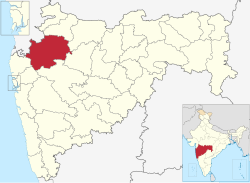
Back منطقة ناشك Arabic ناشيك ARZ नासिक जिला Bihari নাশিক জেলা Bengali/Bangla Districte de Nasik Catalan Nashik (Distrikt) German Distrito de Nashik Spanish Nashik barrutia Basque بخش ناشیک (هند) Persian District de Nashik French
Nashik district | |
|---|---|
Clockwise from top-left: Ramkund Ghat in Nashik, Pandavleni Caves, Triambakeshwar Temple in Trimbak, Salher Fort, Malegaon fort | |
 Location in Maharashtra | |
| Country | |
| State | Maharashtra |
| Division | Nashik |
| Established | 1869[1] |
| Headquarters | Nashik |
| Tehsils | |
| Government | |
| • Type | Zilla Parishad |
| • Body | Nashik Zilla Parishad |
| • Guardian Minister | Dadaji Bhuse (Cabinet Minister MH) |
| • President Zilla Parishad |
|
| • District Collector | Mr. Gangatharan D. IAS |
| • CEO Zilla Parishad | NA |
| • MPs | |
| Area | |
• Total | 15,582 km2 (6,016 sq mi) |
| Population (2011) | |
• Total | 8,107,186 |
| • Rank | 8th (In India), 3rd(In Maharashtra) |
| • Density | 520/km2 (1,300/sq mi) |
| • Urban | 42.53% |
| Demographics | |
| • Literacy | 80.96% [2] |
| • Sex ratio | 931 ♀ / 1000 ♂[3] |
| Time zone | UTC+05:30 (IST) |
| Vehicle registration | MH15(Nashik city) MH41(Malegaon) |
| Major highways | NH-3, NH-60 |
| Website | nashik |
Nashik district,(Marathi: [n̪ɑɕɪk]) formerly known as Nasik district, is a district in Maharashtra, India. The city of Nashik is the administrative headquarters of the district. Nashik is well known for the production of wine. Nashik is also known as Mini Maharashtra, because the climate and soil conditions of Surgana, Peth, Igatpuri resembles with Konkan. Niphad, Sinnar, Dindori, Baglan blocks are like Western Maharashtra and Yeola, Nandgaon, Chandwad blocks are like Vidarbha Region. Nashik is the biggest city in the district while Malegaon is the second biggest city. Manmad, Igatpuri, and Sinnar are some of the big cities situated in the Nashik District. Manmad is one of the biggest railway junctions in India while the city of Malegaon is famous for its powerloom.
Nashik district is the third largest district in Maharashtra state in terms of population of 8,107,187 and occupying an area of 15,582 square kilometres in the north Maharashtra region. It is bounded by Dhule district to the north, Jalgaon district to the east, Aurangabad District to the southeast, Ahmadnagar district to the south, Thane district to the southwest, Valsad and Navsari districts of Gujarat to the west, and The Dangs district of Gujarat state to the northwest.
The Western Ghats or Sahyadri range stretches from north to south across the western portion of the district. With the exception of the westernmost few villages, the western portion is hilly, and intersected by ravines, and only the simplest kind of cultivation is possible. The western slope of the Ghats is drained by several rivers, including the Daman Ganga River, which drains westwards to the Arabian Sea.
The larger eastern portion of the district, which lies on the Deccan Plateau, is open, fertile, and well cultivated. The Satmala-Chandwad Range, which runs east and west, forms the chief divide of the plateau region. Peninsular India's largest river Godavari originates in the district in the Trimbakeshwar Range and continues eastwards through the district.[4] The Satmala-Chandwad Range forms a watershed, such that, the rivers emerging to its south drain into the Godavari. These include the Kadva and Darna both of which are tributaries of the Godavari. To the north of the Satmala-Chandwad Range, the Girna River and its tributary, the Mosam, flow eastward through fertile valleys into the Tapti River.
The Trimbakeshwar Shiva Temple is located in Trimbak, one of the twelve Jyotirlingas, where a set of Hindu genealogy registers at Trimbakeshwar are maintained. The origin of the sacred Godavari River is at Brahmagiri peak near Trimbak.


In February 2016, The Statue of Ahimsa, a 108 ft idol of first Jain tirthankara Rishabhdev carved in monolithic stone was consecrated at Mangi Tungi. It is recorded in the Guinness Book of World Records as the tallest Jain idol in the world.[5]
- ^ "Nashik District was established by British Government". nashik.gov.in. Retrieved 16 August 2021.
- ^ "Nashik District record literacy rate".
- ^ "Nashik District record of sex ratio".
- ^ Chisholm, Hugh, ed. (1911). . Encyclopædia Britannica. Vol. 19 (11th ed.). Cambridge University Press. pp. 247–248.
- ^ "Guinness Book to certify Mangi Tungi idol". The Times of India. Archived from the original on 7 February 2018. Retrieved 17 April 2018.





